center console HUMMER H2 2005 Owners Manual
[x] Cancel search | Manufacturer: HUMMER, Model Year: 2005, Model line: H2, Model: HUMMER H2 2005Pages: 468, PDF Size: 3.21 MB
Page 13 of 468
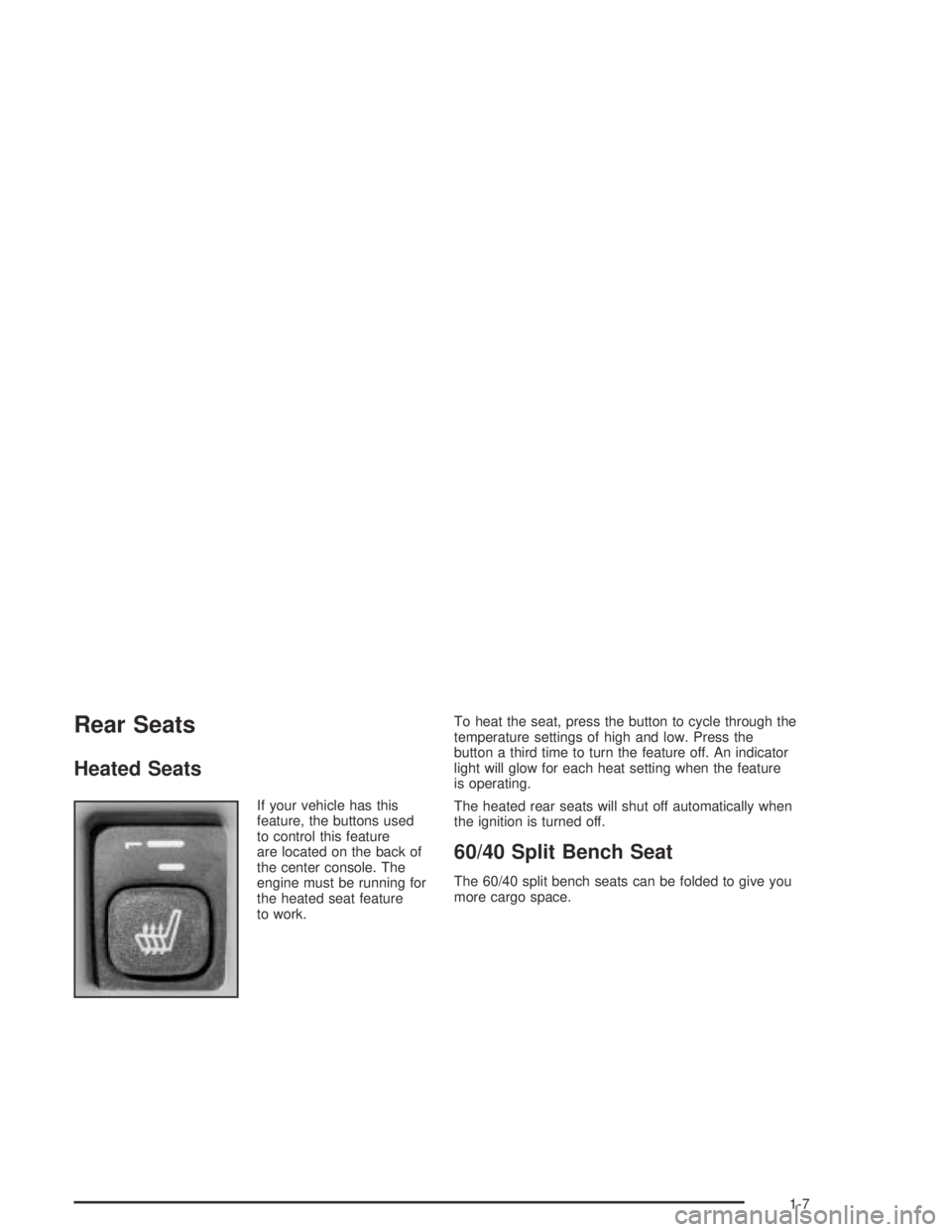
Rear Seats
Heated Seats
If your vehicle has this
feature, the buttons used
to control this feature
are located on the back of
the center console. The
engine must be running for
the heated seat feature
to work.To heat the seat, press the button to cycle through the
temperature settings of high and low. Press the
button a third time to turn the feature off. An indicator
light will glow for each heat setting when the feature
is operating.
The heated rear seats will shut off automatically when
the ignition is turned off.
60/40 Split Bench Seat
The 60/40 split bench seats can be folded to give you
more cargo space.
1-7
Page 78 of 468
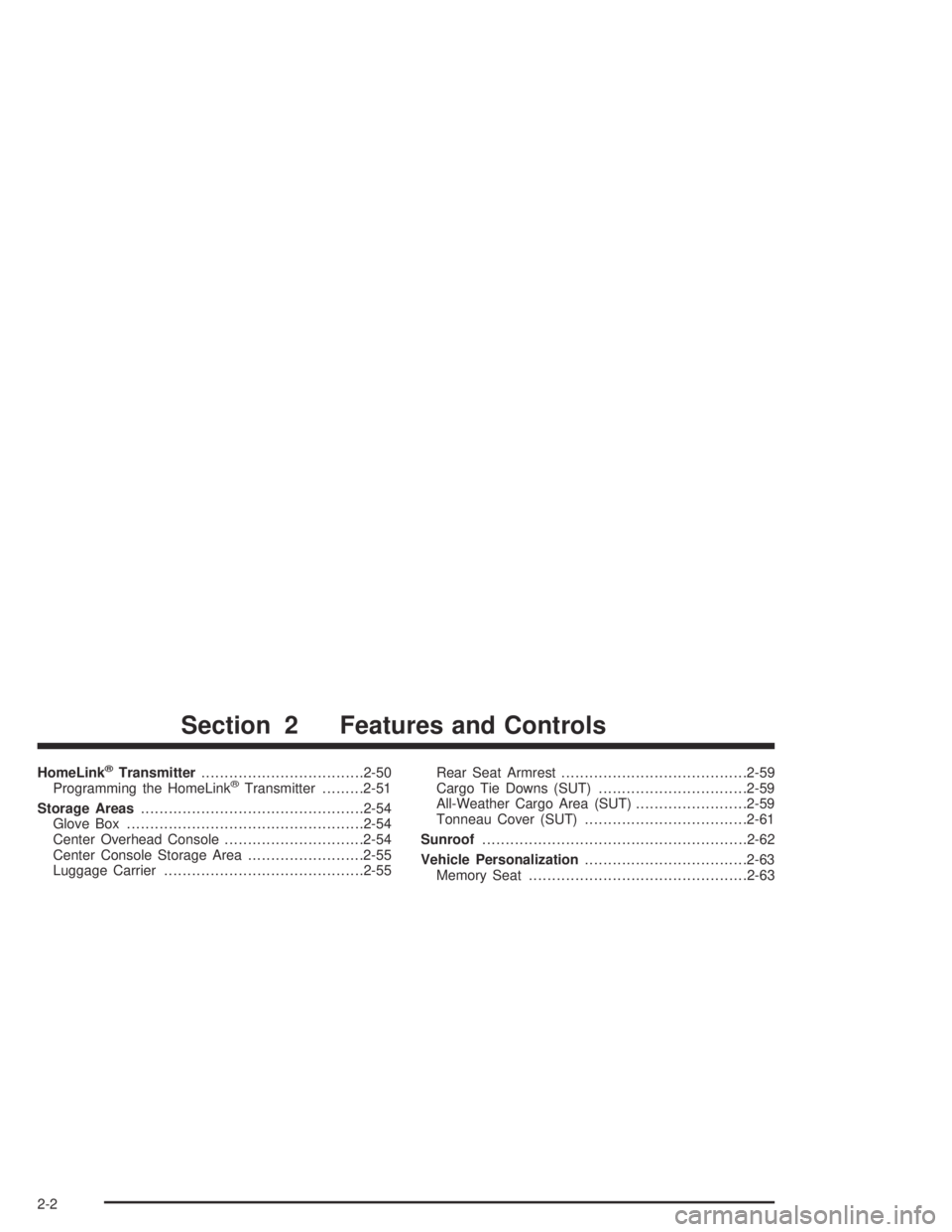
HomeLink®Transmitter...................................2-50
Programming the HomeLink®Transmitter.........2-51
Storage Areas................................................2-54
Glove Box...................................................2-54
Center Overhead Console..............................2-54
Center Console Storage Area.........................2-55
Luggage Carrier...........................................2-55Rear Seat Armrest........................................2-59
Cargo Tie Downs (SUT)................................2-59
All-Weather Cargo Area (SUT)........................2-59
Tonneau Cover (SUT)...................................2-61
Sunroof.........................................................2-62
Vehicle Personalization...................................2-63
Memory Seat...............................................2-63
Section 2 Features and Controls
2-2
Page 130 of 468
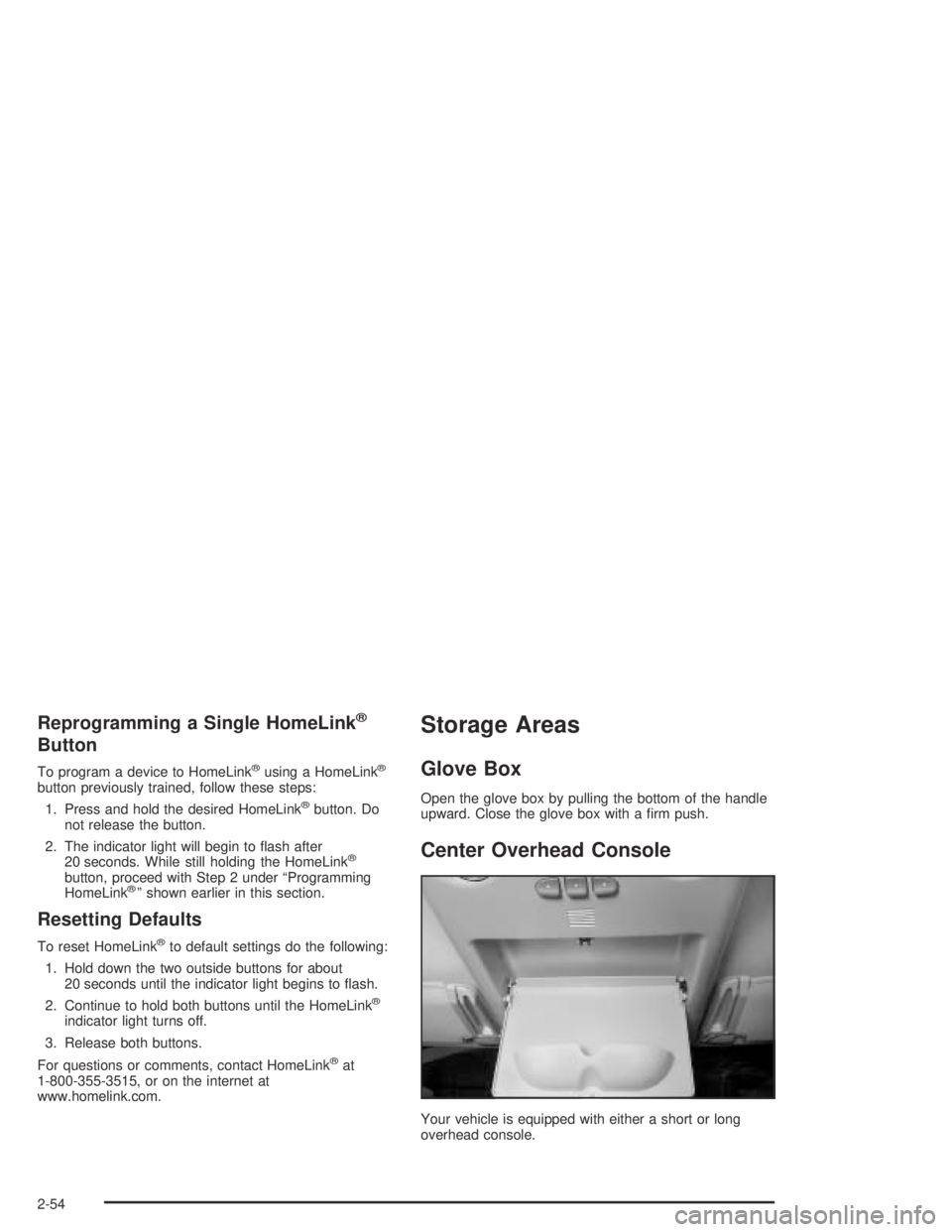
Reprogramming a Single HomeLink®
Button
To program a device to HomeLink®using a HomeLink®
button previously trained, follow these steps:
1. Press and hold the desired HomeLink
®button. Do
not release the button.
2. The indicator light will begin to �ash after
20 seconds. While still holding the HomeLink
®
button, proceed with Step 2 under “Programming
HomeLink®” shown earlier in this section.
Resetting Defaults
To reset HomeLink®to default settings do the following:
1. Hold down the two outside buttons for about
20 seconds until the indicator light begins to �ash.
2. Continue to hold both buttons until the HomeLink
®
indicator light turns off.
3. Release both buttons.
For questions or comments, contact HomeLink
®at
1-800-355-3515, or on the internet at
www.homelink.com.
Storage Areas
Glove Box
Open the glove box by pulling the bottom of the handle
upward. Close the glove box with a �rm push.
Center Overhead Console
Your vehicle is equipped with either a short or long
overhead console.
2-54
Page 131 of 468
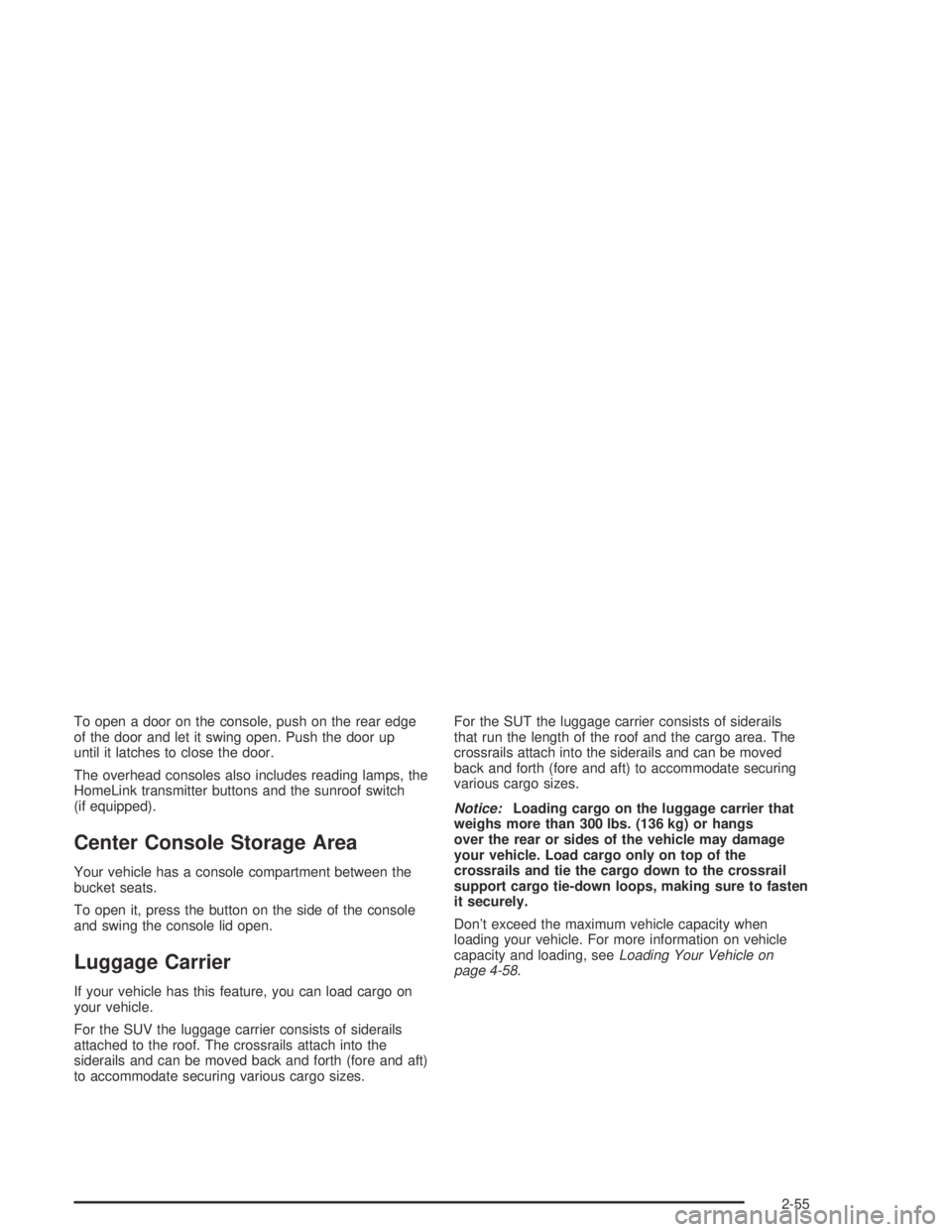
To open a door on the console, push on the rear edge
of the door and let it swing open. Push the door up
until it latches to close the door.
The overhead consoles also includes reading lamps, the
HomeLink transmitter buttons and the sunroof switch
(if equipped).
Center Console Storage Area
Your vehicle has a console compartment between the
bucket seats.
To open it, press the button on the side of the console
and swing the console lid open.
Luggage Carrier
If your vehicle has this feature, you can load cargo on
your vehicle.
For the SUV the luggage carrier consists of siderails
attached to the roof. The crossrails attach into the
siderails and can be moved back and forth (fore and aft)
to accommodate securing various cargo sizes.For the SUT the luggage carrier consists of siderails
that run the length of the roof and the cargo area. The
crossrails attach into the siderails and can be moved
back and forth (fore and aft) to accommodate securing
various cargo sizes.
Notice:Loading cargo on the luggage carrier that
weighs more than 300 lbs. (136 kg) or hangs
over the rear or sides of the vehicle may damage
your vehicle. Load cargo only on top of the
crossrails and tie the cargo down to the crossrail
support cargo tie-down loops, making sure to fasten
it securely.
Don’t exceed the maximum vehicle capacity when
loading your vehicle. For more information on vehicle
capacity and loading, seeLoading Your Vehicle on
page 4-58.
2-55
Page 158 of 468

Accessory Power Outlets
Your vehicle may be equipped with up to �ve accessory
power outlets. The two front outlets, if equipped, are
located under the OnStar
®buttons on the instrument
panel behind hinged doors.
The two middle outlets, if equipped, are located on the
back of the center console.
There may also be an outlet located in the rear of the
vehicle near the liftgate. Remove the cap to use the
outlet. Replace the cap when the outlet is not in use.
If your vehicle is the SUT model, there is an outlet in the
rear cargo area on the passenger’s side of the vehicle.
Notice:Adding any electrical equipment to your
vehicle may damage it or keep other components
from working as they should. The repairs would not
be covered by your warranty. Check with your dealer
before adding electrical equipment.
Certain power accessory plugs may not be compatible to
the accessory power outlets and could result in blown
vehicle or adapter fuses. If you experience a problem,
see your dealer for additional information on the
accessory power plugs.Notice:Improper use of the power outlet can cause
damage not covered by your warranty. Do not hang
any type of accessory or accessory bracket from the
plug because the power outlets are designed for
accessory power plugs only.
Ashtrays and Cigarette Lighter
If your vehicle has an ashtray, it is removable and �ts into
the front cupholder. Pull up on the ashtray door to open it.
Notice:If you put papers or other �ammable items
in the ashtray, hot cigarettes or other smoking
materials could ignite them and possibly damage
your vehicle. Never put �ammable items in the
ashtray.
To remove the ashtray, pull it out from the console. To
reinstall the ashtray, slide it back to the original position.
To use the cigarette lighter, if equipped, push it in all the
way, and let go. When it’s ready, it will pop back out by
itself.
Notice:Holding a cigarette lighter in while it is
heating will not allow the lighter to back away from
the heating element when it is hot. Damage from
overheating may occur to the lighter or heating
element, or a fuse could be blown. Do not hold a
cigarette lighter in while it is heating. Do not use
anything other than the cigarette lighter in the
heating element.
3-18
Page 456 of 468
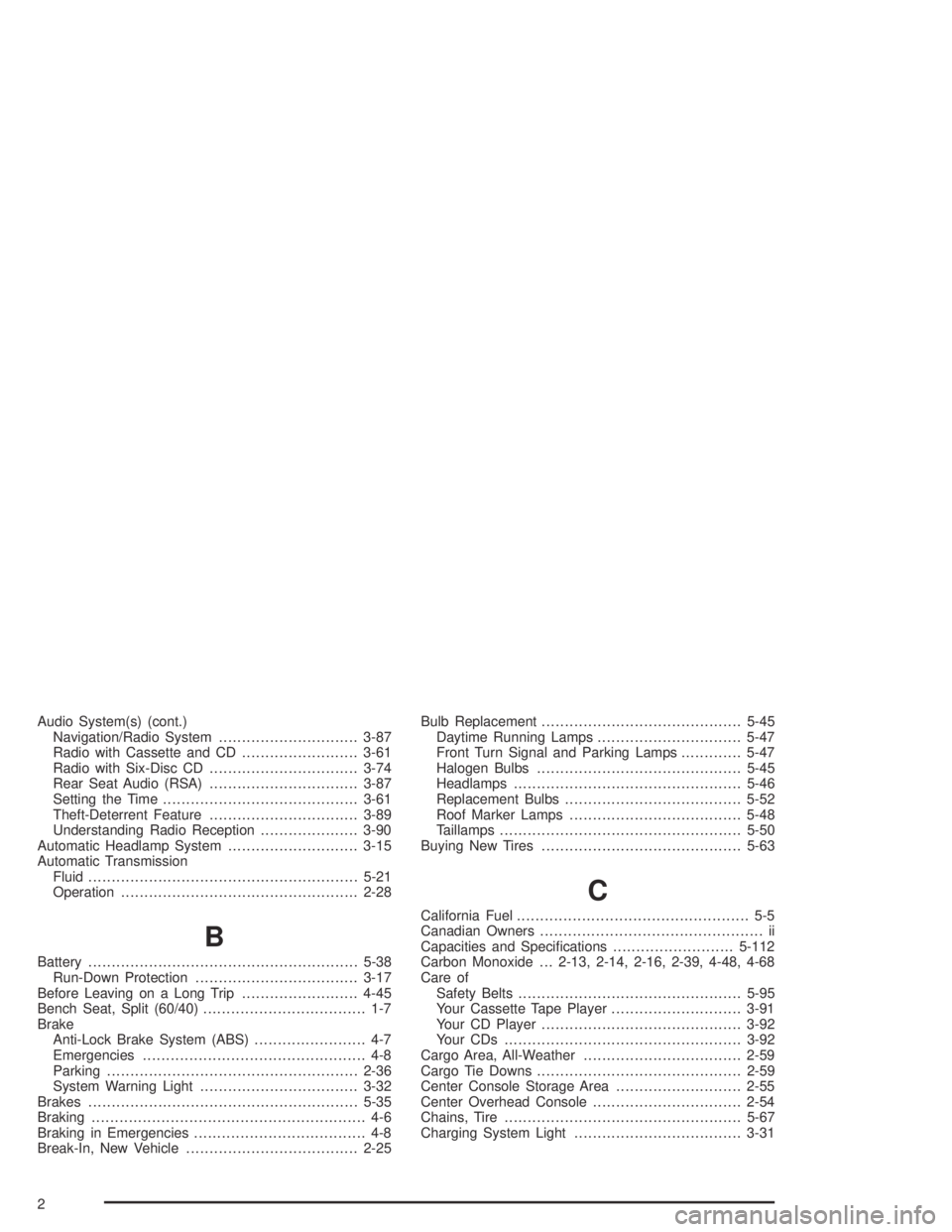
Audio System(s) (cont.)
Navigation/Radio System..............................3-87
Radio with Cassette and CD.........................3-61
Radio with Six-Disc CD................................3-74
Rear Seat Audio (RSA)................................3-87
Setting the Time..........................................3-61
Theft-Deterrent Feature................................3-89
Understanding Radio Reception.....................3-90
Automatic Headlamp System............................3-15
Automatic Transmission
Fluid..........................................................5-21
Operation...................................................2-28
B
Battery..........................................................5-38
Run-Down Protection...................................3-17
Before Leaving on a Long Trip.........................4-45
Bench Seat, Split (60/40)................................... 1-7
Brake
Anti-Lock Brake System (ABS)........................ 4-7
Emergencies................................................ 4-8
Parking......................................................2-36
System Warning Light..................................3-32
Brakes..........................................................5-35
Braking........................................................... 4-6
Braking in Emergencies..................................... 4-8
Break-In, New Vehicle.....................................2-25Bulb Replacement...........................................5-45
Daytime Running Lamps...............................5-47
Front Turn Signal and Parking Lamps.............5-47
Halogen Bulbs............................................5-45
Headlamps.................................................5-46
Replacement Bulbs......................................5-52
Roof Marker Lamps.....................................5-48
Taillamps....................................................5-50
Buying New Tires...........................................5-63
C
California Fuel.................................................. 5-5
Canadian Owners................................................ ii
Capacities and Speci�cations..........................5-112
Carbon Monoxide . . . 2-13, 2-14, 2-16, 2-39, 4-48, 4-68
Care of
Safety Belts................................................5-95
Your Cassette Tape Player............................3-91
Your CD Player...........................................3-92
Your CDs ...................................................3-92
Cargo Area, All-Weather..................................2-59
Cargo Tie Downs............................................2-59
Center Console Storage Area...........................2-55
Center Overhead Console................................2-54
Chains, Tire...................................................5-67
Charging System Light....................................3-31
2
Page 465 of 468
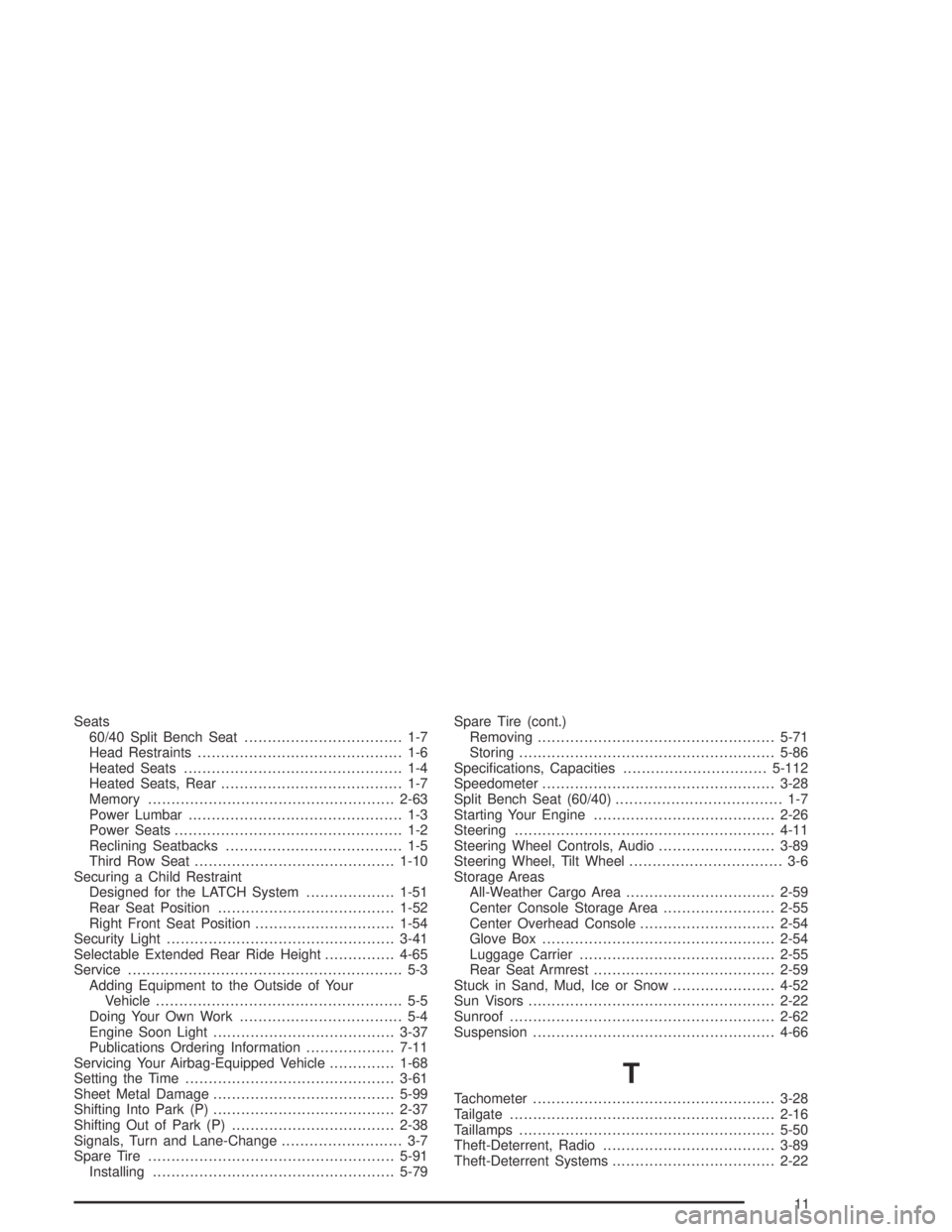
Seats
60/40 Split Bench Seat.................................. 1-7
Head Restraints............................................ 1-6
Heated Seats............................................... 1-4
Heated Seats, Rear....................................... 1-7
Memory.....................................................2-63
Power Lumbar.............................................. 1-3
Power Seats................................................. 1-2
Reclining Seatbacks...................................... 1-5
Third Row Seat...........................................1-10
Securing a Child Restraint
Designed for the LATCH System...................1-51
Rear Seat Position......................................1-52
Right Front Seat Position..............................1-54
Security Light.................................................3-41
Selectable Extended Rear Ride Height...............4-65
Service........................................................... 5-3
Adding Equipment to the Outside of Your
Vehicle..................................................... 5-5
Doing Your Own Work................................... 5-4
Engine Soon Light.......................................3-37
Publications Ordering Information...................7-11
Servicing Your Airbag-Equipped Vehicle..............1-68
Setting the Time.............................................3-61
Sheet Metal Damage.......................................5-99
Shifting Into Park (P).......................................2-37
Shifting Out of Park (P)...................................2-38
Signals, Turn and Lane-Change.......................... 3-7
Spare Tire.....................................................5-91
Installing....................................................5-79Spare Tire (cont.)
Removing...................................................5-71
Storing.......................................................5-86
Speci�cations, Capacities...............................5-112
Speedometer..................................................3-28
Split Bench Seat (60/40).................................... 1-7
Starting Your Engine.......................................2-26
Steering........................................................4-11
Steering Wheel Controls, Audio.........................3-89
Steering Wheel, Tilt Wheel................................. 3-6
Storage Areas
All-Weather Cargo Area................................2-59
Center Console Storage Area........................2-55
Center Overhead Console.............................2-54
Glove Box..................................................2-54
Luggage Carrier..........................................2-55
Rear Seat Armrest.......................................2-59
Stuck in Sand, Mud, Ice or Snow......................4-52
Sun Visors.....................................................2-22
Sunroof.........................................................2-62
Suspension....................................................4-66
T
Tachometer....................................................3-28
Tailgate.........................................................2-16
Taillamps.......................................................5-50
Theft-Deterrent, Radio.....................................3-89
Theft-Deterrent Systems...................................2-22
11